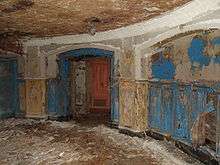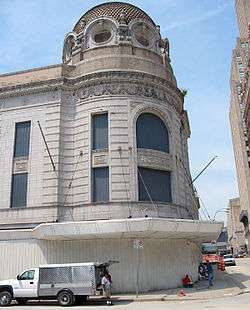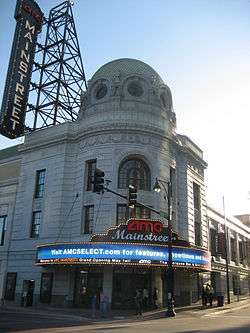Mainstreet Theater
|
Mainstreet Theater in the Power & Light District | |
| Former names |
RKO Missouri Empire Theater |
|---|---|
| Location |
1400 Main Street Kansas City, Missouri |
| Coordinates | 39°05′50″N 94°35′01″W / 39.0971°N 94.5836°WCoordinates: 39°05′50″N 94°35′01″W / 39.0971°N 94.5836°W |
| Owner | Alamo Drafthouse Cinemas |
| Type | movie theater |
| Capacity | 3,200 originally |
| Construction | |
| Opened |
October 30, 1921 Reopened May 1, 2009 |
| Renovated | 1967, 1980, 2008 |
| Closed | 1985 |
The Mainstreet Theater, also commonly referred to as The Empire Theater, is a historic theater located at 1400 Main Street in downtown Kansas City, Missouri. The theater was landmarked and placed on the National Register of Historic Places in February 2007.
Early history

Designed by Rapp & Rapp, the 90,000-square-foot (8,400 m2) theater opened on October 30, 1921 as the Mainstreet Missouri. The 3,200 seat theater was a popular vaudeville and movie house, and the only theater in Kansas City designed by Chicago firm Rapp and Rapp. The interior of the theater was designed in French Baroque style, and the exterior is a blend of neoclassical and French Second Empire. The lobby is topped by a dome encircled by circular windows. The Mainstreet Theater was the largest theater in Kansas City until the Midland Theatre opened in 1927.[1]
The Mainstreet was the first theater in Kansas City to have a nursery for children whose parents were attending a show. The nursery was located in the basement, and it was staffed by a trained nurse. Toys and games were available for older children, and cribs were available for babies. A tunnel connected the lower level of the theater to the nearby President Hotel at 14th and Baltimore.[2] The tunnel was initially created as a means for actors to enter the theater from dressing rooms, but the tunnel also became infamous as a passage for bootleggers to escape police during Prohibition. The supposed tunnel is not shown on the Sanborn fire insurance map for 1939 (The Sanborn Map Co., New York, Kansas City 1939-1940 vol. 1, 1939, Sheet 34). The theater also had space in the basement and sub-basement where animals were kept for vaudeville shows. The space included an elephant cage, a pool for seals, and an elevator large enough and powerful enough to haul elephants to the stage. Noted performers such as Cab Calloway, Charlie Chaplin, Sir Henry Lauder, the Marx Brothers, and Olson & Johnson all head-lined at the vaudeville house. In the early 1920s, at the height of the theater's popularity, attendance at shows averaged over 4,000 daily.
The name of the Mainstreet Theater changed to the RKO Missouri Theater in April 1941.[3] The RKO Missouri ran Cinerama three strip film.
|
Mainstreet Theatre | |
 | |
|
The Mainstreet Theater as it originally appeared, prior to several name changes and removal of the large sign suspended from the roof | |
| Location | 1400 Main St., Kansas City, Missouri |
|---|---|
| Area | less than one acre |
| Built | 1921 |
| Built by | Thompson-Starrett Construction Co. |
| Architect | C.W. Rapp and Geo. L. Rapp |
| Architectural style | Beaux Arts |
| NRHP Reference # | 07000043[4] |
| Added to NRHP | February 15, 2007 |
The AMC Era
AMC Theaters, then known as Durwood Theatres, bought the theater in the late 1950s and reopened it in December 1960 as the Empire. The first film shown at the theater under the new name was Exodus. The standard seating configuration of the new Empire was reduced to 1260 in order to accommodate more modern amenities and technology upgrades. Under Durwood, the Empire began running the seamless 70 mm film version of Cinerama, replacing the three strip Cinerama. The 70 by 30-foot (9.1 m) Walker Hi Gain motion picture screen was designed to collapse, fold, and store on stage within two and a half hours to allow for quick conversion for live stage events. The stage curtain measured more than 120 feet (37 m) and claimed to be the largest in the world. In fitting with Kansas City's reputation as the "City of Fountains", the Empire included decorative fountains in the box office area and at the main staircase. The prominent signage suspended from scaffolding attached to roof of the building during the "Mainstreet" and "RKO Missouri" eras was removed when Durwood converted the theater to the Empire. The Empire did keep an organist until 1961, when there was a dispute with the musicians' union.
In 1967, the theater was split into two parts when a second theater was constructed in the former balcony of the original theater.[5] In 1980 AMC converted the Empire into four theaters and it was known as Empire 4 Theaters. Two of the additional theaters were located in the upper level where the original balcony once existed.[6] The Empire stopped screening films and closed in 1985.[7]
In 1972, as a protest against what it called "cultural prejudices", the Italian American Unification Council in Kansas City spent $2,500 to purchase all the seats of the premier showing of Francis Ford Coppola’s film The Godfather at the Empire. While the film played to an empty house, the Council sponsored a benefit dance down the street.[8][9]
An Uncertain Future

Prominent downtown landowner Larry Bridges purchased the Empire Theater in 1986 from Stan Durwood, then CEO of AMC Theaters. Between 1985 and 2005, the Empire was at risk for demolition on several occasions. Numerous efforts took place to prevent each demolition attempt. In 1986, actor and comedian George Burns even joined the effort and wrote a letter on behalf of the effort to have it declared a historic landmark. Since the theater was not listed as a local landmark or listed on the National Register of Historic Places, there was not much legal protection to prevent demolition of the deteriorating structure.
Owner Larry Bridges expressed desire to raze the Empire several times and even obtained a pre-demolition inspection permit from the city in August 2003. Bridges planned to team with DST Realty to build a new headquarters for Kansas City Power & Light on the site. The City of Kansas City blocked the plan, which had called for saving the facade but demolishing the core structure of the Empire.
In 2004, the Kansas City Chapter of the American Institute of Architects compiled a list of 25 buildings in the central business district believed to be significant downtown landmarks "worthy of attention and reuse". The Empire Theater was listed as the most endangered building at the time the list was compiled. The building had fallen under such an extreme state of disrepair that bricks were falling from the building and trees were sprouting from the roof.
Redevelopment
The City of Kansas City reached an agreement to purchase the theater from Larry Bridges in late 2004 while it was acquiring properties for the future Power and Light District.[10] In November 2005, the State of Missouri approved up to $938,538 in Brownfields Redevelopment Program remediation tax credits to help offset costs involved in the cleanup of asbestos at the theater. An estimated 200 dump-truck loads of asbestos and mold-covered debris were removed from the theater during the cleanup process. Power & Light District developer Cordish reached an agreement with AMC to form a joint venture, Midland-Empire Partners LLC, to redevelop both the Empire Theater and the nearby Midland Theatre.
Re-Opening
The AMC Mainstreet Theater opened to the public under its original name as part of the Power & Light District on May 1, 2009, after a test period of playing second-run films for employees and invited guests beginning April 18, 2009. The theater also hosted the Kansas City Film Festival April 22–26, 2009.[11] AMC stated that the Mainstreet is its "flagship theater", spending $30 million on the renovation.[12]
The renovated theater features six auditoriums, on two floors. The ground floor has three standard auditoriums, while the upper level features "cinema suites" with reclining loungers, food trays, and a call button to summon a server.[12] All auditoriums feature 4k digital projection[13] and 11 channel sound, including overhead speakers and bass shakers mounted under the seats. AMC claims that it is one of the most technologically advanced theater setups in the world. All six auditoriums feature reserved seating.
The lobby area features a restaurant called The Marquee which opened on Friday, March 27, 2009.[14]
Early reports claimed that the theater would feature "documentaries, independent, and foreign films", but upon opening the selection was limited to mainstream Hollywood films.[15]
On May 26, 2009, the theater was awarded the "Dr. George Ehrlich Achievement in Preservation Award" by the Historic Kansas City Foundation.
Change of ownership
On June 4, 2012, it was announced that Alamo Drafthouse Cinemas would be taking over operations of the theater.[16] As of June 25, 2012 Alamo Drafthouse has the Mainstreet theater listed on their web site and is selling tickets.[17]
References
- ↑ Milstein, Cydney E.; Warfield, Mary Ann (August 7, 2006). "National Register of Historic Places Registration Form: Mainstreet Theatre" (PDF). National Parki Service. Retrieved 2009-05-05.
- ↑ "CinemaTours: Cinema History Around The World - Mainstreet Theater". Kansas City Times. April 24, 1987. Retrieved 2009-07-25.
- ↑ "RKO Missouri to Become the Empire Theater". Kansas City Star. 1960-09-11. p. 25A.
- ↑ Staff (2009-03-13). "National Register Information System". National Register of Historic Places. National Park Service.
- ↑ "Kansas City 'Empire' Reopens After Facelifting". Physical Theater 16 (3): 6–7. 1961-03-15.
- ↑ "Broad-Scale Campaign Ties 'Grand Prix' With Opening Of Empire II In Kansas City". Boxoffice. 1967-02-06.
- ↑ "End of the Empire--Longtime Downtown Theater Closed". Kansas City Star. 1986-10-25. pp. 1A–5A.
- ↑ "Blackhand Strawman."
- ↑ "."
- ↑ "Kansas City buys Empire Theater". Kansas City Business Journal. 2004-12-30.
- ↑ "Kansas City FilmFest". Retrieved 2009-05-01.
- 1 2 Penn, Steve (2009-04-14). "New AMC Mainstreet Theater will revolutionize movie-going downtown". Kansas City Star. Retrieved 2009-04-14.
- ↑ AMC to Get Sony Digital Projectors - New York Times - March 29, 2009
- ↑ Smith, Joyce (2009-03-27). "Bar and grill opens today downtown". Kansas City Star. Retrieved 2009-03-27.
- ↑ RobbKC (2007-08-27). "Kansas City's restored Midland, Mainstreet Theaters will reopen". cinematreasures.org. Retrieved 2009-07-10.
- ↑ "Alamo Drafthouse Cinema to Take Over Mainstreet Space in Downtown KC." kansascity.com Retrieved on June 4, 2012.
- ↑ "Mainstreet". Alamo Drafthouse. Retrieved 16 July 2012.
| Wikimedia Commons has media related to Mainstreet Theater. |
| ||||||||||||||||||||||||||
| ||||||
